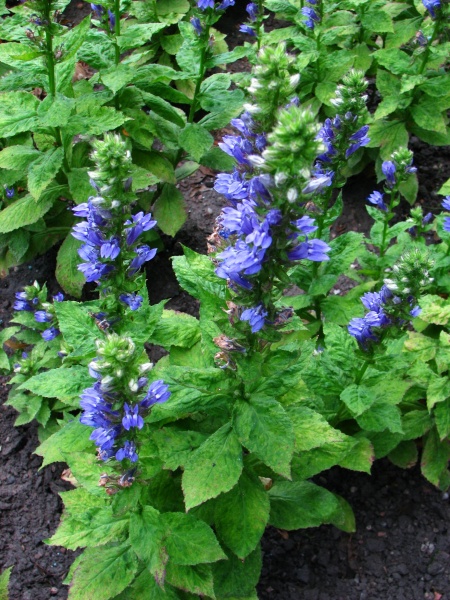 Known to be toxic - Toxic to mammals if ingested.
Known to be toxic - Toxic to mammals if ingested.

Source: Agnieszka Kwiecień
Lobelia siphilitica
Great Blue Lobelia
Lobélie bleue
Synonyms
blue cardinal flower
great lobelia
Seeds in stock
Available at table Mixed Sun, Wet
Available at table Mixed Sun, Wet
We currently accept seeds for this plant
Bloom Colour: Blue
Bloom Period: Jul - Sep
Max Height: 3.0 feet
Max Width: 1.5 feet (spreads by rhizome)
Light Condition:
 More than 6 hours of direct sun a day
More than 6 hours of direct sun a day
 More than 2 or 3 hours but less than 6 hours of direct sun a day
Soil conditions:
More than 2 or 3 hours but less than 6 hours of direct sun a day
Soil conditions:
 Tolerates medium soil condition
Tolerates medium soil condition
 More than 6 hours of direct sun a day
More than 6 hours of direct sun a day
 More than 2 or 3 hours but less than 6 hours of direct sun a day
More than 2 or 3 hours but less than 6 hours of direct sun a day
 Tolerates medium soil condition
Tolerates medium soil condition
Lifespan:
Perennial
plants that will that come back year after year
Gardener Experience:
 Suitable for beginner gardeners
Suitable for beginner gardeners
 Does not spread uncontrollably
Does not spread uncontrollably
 Easy to germinate
Easy to germinate
 Self-seeding
Self-seeding
 Suitable for beginner gardeners
Suitable for beginner gardeners
 Does not spread uncontrollably
Does not spread uncontrollably
 Easy to germinate
Easy to germinate
 Self-seeding
Self-seeding
Landscape Uses:
 Suitable for wetland garden
Suitable for wetland garden
 Suitable for rain gardens
Suitable for rain gardens
 Suitable for shoreline rehabilitation
Suitable for shoreline rehabilitation
 Suitable for container garden
Suitable for container garden
 Suitable for school gardens
Suitable for school gardens
 Tolerates boulevard garden conditions
Tolerates boulevard garden conditions
 Suitable for wetland garden
Suitable for wetland garden
 Suitable for rain gardens
Suitable for rain gardens
 Suitable for shoreline rehabilitation
Suitable for shoreline rehabilitation
 Suitable for container garden
Suitable for container garden
 Suitable for school gardens
Suitable for school gardens
 Tolerates boulevard garden conditions
Tolerates boulevard garden conditions
Ecological Benefits:
 Supports hummingbirds
Supports hummingbirds
 Supports birds
Supports birds
 Supports pollinators
Supports pollinators
 Supports hummingbirds
Supports hummingbirds
 Supports birds
Supports birds
 Supports pollinators
Supports pollinators
Tolerates:
 Deer resistant
Deer resistant
 Rabbit resistant
Rabbit resistant
 Tolerates foot traffic around the plant
Tolerates foot traffic around the plant
 Tolerates limestone conditions
Tolerates limestone conditions
 Tolerates juglone conditions
Tolerates juglone conditions
 Tolerates transplantation
Tolerates transplantation
 Deer resistant
Deer resistant
 Rabbit resistant
Rabbit resistant
 Tolerates foot traffic around the plant
Tolerates foot traffic around the plant
 Tolerates limestone conditions
Tolerates limestone conditions
 Tolerates juglone conditions
Tolerates juglone conditions
 Tolerates transplantation
Tolerates transplantation
Special Features and Considerations:
Plant Location
Native to Ottawa region: Yes
Distribution according to VASCAN

Ephemeral
Native
Introduced
Excluded
Extirpated
Doubtful
Absent
Thrives in Ecozones
- Boreal Plains
- Mixed Wood Plains
Ecological Benefits
Butterflies Supported by Lobelia siphilitica
- Epargyreus clarus (Silver Spotted Skipper)
Specialized Bees Supported by Lobelia siphilitica
No bee data available for this plant.
Plants that grow in similar conditions, that bloom at the same time.
Complementary Plants
- Glyceria canadensis
Canada Mannagrass
Glycérie du Canada - Helenium autumnale
Common Sneezeweed
Hélénie automnale - Hibiscus moscheutos
Swamp Rose-mallow
Ketmie des marais - Impatiens capensis
Spotted Jewelweed
Impatiente du Cap - Physostegia virginiana
Obedient Plant
Physostégie de Virginie
Substitute For Non-Native Plants
- Buddleia (Butterfly Bush)
- Delphinium (Delphinium)
- Iris pseudacorus (Yellow Iris)
- Iris (Iris Cultivars)
- Hesperis matronalis (Dame Rocket)
Sowing Information
Download Seed Envelope Labels (PDF)
- Sowing depth: Surface sow
- Sow by February
- Stratification duration: 60 days
- Self-seeding
Harvesting and Seed Sharing
- Harvest start month: October
- Harvesting indicator:
- Pods are brown, seeds are dark, and crisp, and little stem connecting the pod to the main stem is brown (not green)
- Harvesting:
- Cut stem (including pods), let air dry in paper bag, then shake seeds off after a few days
- Seed viability test:
- No test needed before donating
- Packaging measure: Half of one, 1/32 teaspoon
- Seed storage:
- Air dry in paper bag or open container, for a few days until crisp
- Shake seeds to move them once in a while to prevent molding
- Cultivar: Yes, do not donate unless you know source, and there are no known cultivars in your garden or at proximity
- Remove non-seed material
- Harvesting video: Watch here
Toxicity Notes
Toxic to mammals if ingested.


 Canadensis
Canadensis
